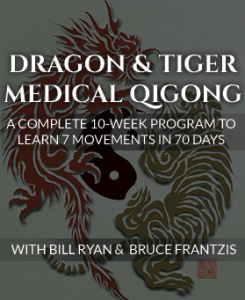The Relationship of Qigong to Martial Arts Form Training
Within internal martial arts, internal power is taught through two primary methods. In the first, you learn internal power by first studying neigong/chi gung as a separate art. This study accomplishes several purposes:
- The health of your body is upgraded
- You acquire a clear awareness of chi and
- You have absorbed into your body an
understanding of the nature of the internal work you need to develop for the specific martial art you are attempting to master
All this internal work occurs without you being burdened by an initial need to learn the complex physical coordination necessary to do martial movement well. In the early phases of starting something new, learning one challenging skill at a time is not only easier but is often a more productive long-term strategy for doing mind/body work. Learning two challenging skills simultaneously is more difficult and time consuming.
Tackling one skill at a time is best for those with limited free time to study. Next, you learn the movement and fighting applications of your specific internal martial arts style, incorporating the newly acquired neigong components into all your physical movements.
After your body has more or less absorbed a basic ability to fuse the internal energy work within your physical movements, you can focus on amplifying your internal power to the maximum. This intensification can be done with progressively more advanced stages of training, both within your developmental solo martial art form work and in combat training with opponents.

The purpose of this stage is to dramatically shift your emphasis, to get you to rely on chi for power, rather than on the habit of relying on physicality for power. After this stage has stabilized, the practitioner finally begins to learn the most advanced chi work of the internal martial arts within the martial movements themselves, and not within separate chi gung sets.
The discussion has thus far concentrated on those learning internal martial arts. If you practice aikido or external martial arts, such as karate or tae kwon do or such external/internal martial arts as silat or many kinds of gung fu, learning qigong can greatly upgrade your internal power base. If an internal martial arts master is willing and is sufficiently mentally flexible, you can be taught how to adapt the chi gung material to your specific martial art. After all, tai chi chuan was originally created by fusing regular external martial arts with neigong.
In the same way,nei gung could be added to karate or any other not fully internal martial art. Aikido practitioners, who are already seriously interested in ki work (ki is Japanese for Chinese word chi), would especially benefit from the upgrades of nei gung/chi gung’s highly systematic internal energy chi training, especially in the area of health. Neigong can extend the physical prowess of external martial artists, possibly for decades, spark their creativity, and compensate for any boredom they might be experiencing with their style.






0 Comments